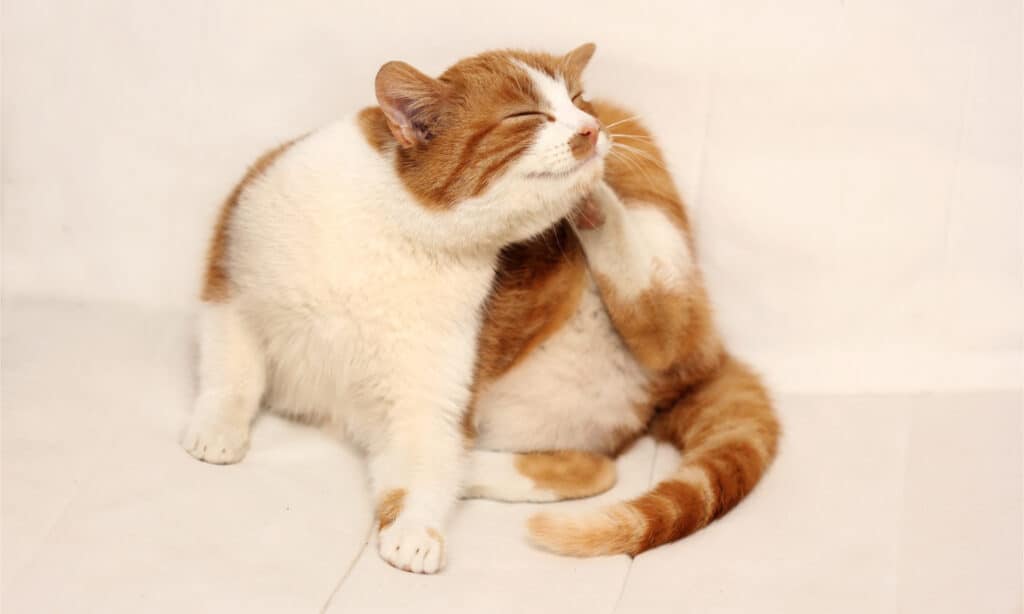Diatomaceous earth naturally occurs in our world. Made from the crushed fossils of the tiny shells from ocean organisms (diatoms), the substance boasts many uses. This gentle abrasive substance is made up of approximately 80-90% silica, which makes it great for drying things out. Cat owners worldwide use diomataceous earth to help their cats for several reasons. From getting rid of worms to keeping odor down in the litter box, the substance has many applications. Before we learn about the important things to know before using diomataceous earth for cats, let’s discover the most common use: killing fleas!

Diatoms are microscopic organisms with shells made of silica. When crushed into a powder, it makes diomataceous earth.
©Elif Bayraktar/iStock via Getty Images
Killing Fleas on Your Cat with Diomataceous Earth

Selecting safe, effective products to eliminate your cat’s fleas can seem daunting, but diomataceous earth can help!
©Natata/Shutterstock.com
If your cat has fleas, you surely want to get rid of them. When fleas bite, they cause tiny, itchy bumps on the skin. Some cats even have allergies to flea bites, which can result in a horribly itchy and bloody fiasco on your cat’s skin. Open sores from scratching can become infected, then the whole ordeal becomes an absolute nightmare. A flea infestation can also cause anemia (low red blood cell count) which can lead to death in small kittens.
Although many products exist on the market to kill and prevent fleas, most of them are chemical-based. This presents problems for many cats, especially those prone to seizures. Most of them are not safe to use on kittens less than 8 weeks old. They can also be very expensive, especially if you have several cats. So, what can you do?
An inexpensive and safe alternative for flea treatment in cats is diomataceous earth. You can apply a thin layer of the powder along your cat’s spine. Diomataceous earth is a desiccant. That means it helps dry things out. The sharp edges of the particles slice through the exoskeleton (hard outer layer of insects). This allows the powder to get inside their body and dry them out, which kills them off pretty quickly. The particles are too small to damage your cat’s skin. Fun fact, it can also be used on dogs!
Killing Fleas in Your Home with Diomataceous Earth
Diomataceous earth is also effective at eliminating fleas when it’s applied around your home. Spread a thin layer around the baseboards of your home. You’ll also want to put it anywhere that’s dark such as under the couch, refrigerator, stove, and throw rugs. Fleas only spend about 10% of their time on the host. The rest of their time is spent breeding and laying eggs in dark places. Diomataceous earth is one of the few substances that kills fleas, flea eggs, and flea larvae on contact! Another perk of using diomataceous earth around your home is that it kills many other insects. In fact, it’s one of the few pet-safe roach control options for your home!
Generally, diomataceous earth is safe to use around cats. However, a few precautions must be taken to avoid serious health complications. Let’s learn about the 3 important things to know before using diatomaceous earth for cats!
#1 The Most Important Things About Diatomaceous Earth For Cats: Don’t Inhale

Inhaling diomataceous earth causes sneezing, coughing, and lung damage.
©koldunova/iStock via Getty Images
While there are so many uses for diatomaceous earth both for you and your cat, use extreme caution to not inhale the product. Because the tiny fossilized shell particles have very sharp edges, they can damage the lining of your esophagus, trachea, and lungs. This leads to sneezing, coughing, and potentially difficulty breathing. These symptoms can become life-threatening if not resolved quickly.
If your cat is particularly curious and likely to sniff at diomataceous earth around the home, it’s better to find an alternative. This is especially true if your cat already suffers from allergies or asthma. If you or your cat inhale diatomaceous earth, go to the hospital/veterinarian immediately.
#2 Food Grade vs. Industry Grade

Diatomaceous earth comes in two forms: food-grade and industry-grade.
©FotoHelin/Shutterstock.com
Another critical thing to know about using diatomaceous earth for cats is that you must choose the only food-grade version. That’s because of the different processes for creating food-grade versus industry-grade. For industry-grade diomataceous earth, the processing allows for arsenic and heavy metals to remain in the product. This version is often used to clean swimming pools. Another problem with industry-grade diomataceous earth is that it contains a higher level of crystalline silica due to the heat process used to make it. This crystalline silica in this form of diomataceous earth is considered a carcinogen (a substance with the potential to cause cancer).
Also, be careful when reading packages, as some food-grade diatomaceous earth does not contain labeling for human consumption. Only select a product that contains this description before using it for yourself or your cat.
#3 Keep it Out of the Eyes

Diatomaceous earth can irritate and damage your cat’s eyes.
©dimarik/iStock via Getty Images
Just as the diomataceous earth can cause damage to the sensitive parts of your cat’s respiratory tract, it can also severely damage the eyes. The sharp edges of the diomataceous earth particles can cause scratches on the cornea (surface of the eye). Left untreated, these wounds can cause loss of vision or even require the eye to be removed. If your cat begins to squint its eyes, rub/paw at them, or has excessive tearing after using diomataceous earth on or around them, take them to the veterinarian right away.
The photo featured at the top of this post is © marekuliasz/iStock via Getty Images
Thank you for reading! Have some feedback for us? Contact the AZ Animals editorial team.







